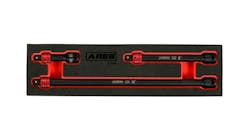Back in the day when transmissions had governors, it was easy to diagnose a wrong gear start problems. There was either a governor regulation issue or a stuck shift valve. Today, with transmissions being totally computer controlled, wrong gear starts is not as easy to diagnose. This becomes especially frustrating when there are no codes to accompany the problem.
Earlier 41TE (A604) transmissions have issues similar to this. You would come to a complete stop and be in second gear. When taking off, it would drop to first, other times it would stay in second then shift to third and fourth as if all was well. Occasionally, a low/reverse pressure switch code would finally set. From dealing with several of these complaints on our technical hotline, it seems that if the low/reverse pressure switch does not close fast enough when first gear is commanded, a no limp second gear start occurs. When a low/reverse pressure switch code finally logs, limp is initiated.
FIGURES 1-3
We are seeing similar wrong gear start problems with Chrysler RFE transmissions. Recently, in a local shop, a 2006 Dodge Ram 1500 4.7L was misbehaving in the same fashion as the 41TE. ATSG Tech Jose Garcia went to the shop and ran some checks. To his surprise, when doing voltage and resistance checks he discovered an out of range low/reverse solenoid. Yet the computer never logged a code for a low/reverse solenoid circuit fault. It did however intermittently log a low/reverse pressure switch code. After changing the solenoid assembly the transmission operated flawlessly.
Except for the line pressure solenoid, all clutch control solenoids measure around 1.5 to 2.0 ohms (Figure 1). The low/reverse solenoid measured 6.76 ohms (Figure 2). With this type of resistance, the dynamic response of the solenoid was sluggish affecting the time it takes to close the low/reverse pressure switch.
Why the computer did not code with having such high resistance is still a mystery to us. The shop Jose went to did not have a scope to monitor the low/reverse solenoid so the fly back voltage is unknown. Chrysler’s strategy in setting solenoid electrical fault codes is to do just that. John Thornton, a well respected diagnostician and seminar speaker has conducted several seminars showing this. With early TCMs, fly back voltage should be near 40 volts. New Generation Computers such as this 06 Ram 1500 should be near 42 volts (Figure 3). If the expected threshold is not reached, a code SHOULD set. Apparently there are exceptions.
FIGURES 4-6
I asked to have the solenoid assembly so I could see where the high resistance was originating from. As seen in Figure 2, the low/reverse solenoid measured 6.76 ohms at the solenoid assembly connector. I disassembled it and located the solenoid inside the assembly. With a meter directly on the solenoid, it measure 6.23 ohms (Figure 4) confirming the problem to be the solenoid itself.
Upon a closer look (Figures 5 and 6), the coil wires are pinched fitted into the contact blades. The right side wire was higher than the left. I made an attempt to get leads on the coil wires themselves to see if the resistance was in the coil itself. At first I thought my leads were not pointed enough to reach the wires as I could not obtain a reading. I then checked the resistance again on the blades and had an open circuit. I apparently disturbed a wire that was just nearly hanging on.
Volkswagen’s DSG transmissions have similar constructed solenoids that from time to time fail in this way also. One big difference is, these solenoids have enough room to solder the wire directly onto the contact blade saving the solenoid. If you are in a pinch, with the RFE solenoid assembly, instead of tossing bad ones away, it’s not that difficult to replace solenoids and save a pack.
FIGURES 7-8
Just one word of caution, for solenoid assemblies with black or white color connectors, there are two normally applied solenoids while the other 4 are normally vented (Figure 7). Solenoid assemblies with grey color connectors have 2 normally applied and 3 normally vented solenoids (the OD solenoid was eliminated). With two different style solenoids you must be sure to place them in their correct locations. You will see either black or white blotches on the top of the two solenoids that are normally applied to ensure their proper locations (Figure 8).
Subscribe to Motor Age and receive articles like this every month…absolutely free. Click here
.jpg?auto=format,compress&fit=max&q=45&w=250&width=250)
.jpg?auto=format,compress&fit=max&q=45&w=250&width=250)
.jpg?auto=format,compress&fit=max&q=45&w=250&width=250)
.jpg?auto=format,compress&fit=max&q=45&w=250&width=250)
.jpg?auto=format,compress&fit=max&q=45&w=250&width=250)
.jpg?auto=format,compress&fit=max&q=45&w=250&width=250)
.jpg?auto=format,compress&fit=max&q=45&w=250&width=250)
.jpg?auto=format,compress&fit=max&q=45&w=250&width=250)

